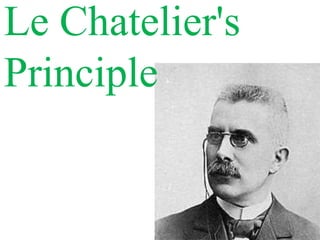
Le Chateliers Principle 3.pptX CHEMISTRY
- 2. Use Le Chatelier’s Principle to explain how the position of a system at equilibrium is effected by: Changing concentration Changing temperature Changing pressure Adding a catalyst
- 3. Le Chatelier's Principle (1884) When a system at equilibrium is subjected to a stress, the system will adjust so as to relieve the stress. Remember: Kc value is constant. BEFORE the stress, and AFTER the reaction adjusts to the stress.
- 5. 1. Concentration stress Any change in concentration of products or reactants by adding or removing to a balanced system. Reduction in stress due to increased collisions and a redistribution of excess particles. • Add – system shifts to use it up. • Remove – system shifts to make more.
- 6. • More C means increased rate of reverse reaction. Kc = [C] [A][B] C B A + Kc = 1.35 We say “shifts left” We mean: • Excess C used up until ratio of product to reactant concentrations is equal to Kc once again. Increase [C]:
- 7. Kc = [C] [A][B] B C A + Kc = 1.35 • Forward reaction is favoured We say “shifts right” We mean: • New concentrations re-establish Kc. Increase [B]:
- 8. Kc = [C] [A][B] B C A + Kc = 1.35 Removing a particle is like decreasing [ ]. • Decreased rate of forward reaction. We say “shifts left” We mean: • Reverse is favoured, ↑ reactants, Kc the same. Decrease [A]:
- 9. 2 NO2 (g) N2O4 (g) car exhaust smog Huge spike indicates that [ ] was changed by adding more particles.
- 10. 2 NO2 (g) N2O4 (g) car exhaust smog A huge spike indicates that [ ] was changed by removing particles.
- 11. Temperature
- 12. Temperature stress addressed the SAME way as concentration by changing collision rates. **Re-establishes new eqlbm (with new [ ]s) at new temperature – SO…changes the Kc. Exothermic: A B (- ∆H ) Endothermic: A B (+ ∆H) HEAT + + HEAT 2. Temperature stress
- 13. Temperature increase / add heat • Reaction shifts left. • Endothermic collisions (reverse) favored. Temperature decrease / removing heat • Reaction shifts right to produce more heat. • Exothermic collisions (forward) favored. + heat heat A B + A B Kc = [B] [A] Kc = [B] [A]
- 14. ∆H = -58 kJ 2 NO2 (g) N2O4 (g) car exhaust smog
- 15. ∆H = -58 kJ 2 NO2 (g) N2O4 (g) car exhaust smog
- 16. Volume/Pressure
- 17. Changing the pressure of a system only affects those equilibria with gaseous reactants and/or products. 3. Volume stress Rates of collisions change with pressure and effect all concentrations – BUT, Kc will re-establish. A + 2 B C
- 18. A + 2 B C Volume increase – (↓P ): A B B C Decreased rate of forward reaction. (fewer collisions, in larger space) Reverse rate favoured – shifts left (pressure increases with more particles) B B A
- 19. A + 2 B C A B B C C Volume decrease– (↑P ): Increased rate of forward reaction. (MORE collisions, in smaller space) Forward rate favoured – shifts right (pressure reduced with fewer particles)
- 20. Which way with the system shift IF the size of the container is cut in half? Reverse reaction favoured (increased likelihood of collisions in a smaller space) Shifts left 2 NH3(g) N2(g) + 3 H2(g)
- 21. Equilibrium position unchanged. H2(g) + I2(g) 2 HI(g) Which way with the system shift IF the pressure is decreased? 1 + 1 : 2 Pressure changes have NO effect on this eqlbm – Same # of particles, same collision effects.
- 22. Factors (stresses) that do not affect Equilibrium Systems
- 23. Catalysts Lowers activation energy for both forward and reverse reaction equally. Equilibrium established more quickly, but position and ratios of concentrations will remain the same. K value remains the same.
- 24. Inert Gases (noble gases) Unreactive – are not part of a reaction, therefore can not affect equilibrium of a concentration-based equation. Catalysts, inert gases, pure solids or pure liquids do NOT appear in the mass action expression - so they cannot have an effect if altered.
- 26. Haemoglobin protein used to transport O2 from lungs to body tissue. Lungs - [O2] is high - forward reaction favored Haemoglobin binds to the excess O2. Tissue - [CO2] is high and [O2] is low - reverse reaction favored. Hb releases O2. Hb (aq) + O2 (g) HbO2 (aq) Haemoglobin Production and Altitude
- 27. Hb (aq) + O2 (g) HbO2 (aq) High altitudes - [O2] is very low - reverse reaction favored. Hb release O2, fewer Hb bind oxygen. Result in exaggerated lack of oxygen to the tissues, resulting in headache, nausea and fatigue. Over time, body adjusts by producing more haemoglobin molecules. Increases [Hb] in the blood stream shifts equilibrium right - more O2 bound and transported to the tissue.
- 28. Appliance - NO energy - forward reaction favored Energy release to run appliance. Outlet (recharge) - high energy - reverse favored Reforming the reactants, storing the energy for use. Rechargable Batteries Lead-acid PbO2 + Pb + 4 H+ + 2 SO4 2- 2 PbSO4 + 2 H2O + energy Nickel-cadmium Cd + 2 NiO(OH) + 2 H2O 2 Ni(OH) + Cd(OH)2 + energy Electrical energy (like heat) is written in the reaction.
- 30. N2(g) + 3H2(g) 2NH3(g) ΔH = -92.4 kJ mol-1 high pressure medium temperature - catayst remove ammonia high reactant concentrations